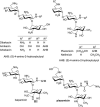Amphiphilic aminoglycosides: Modifications that revive old natural product antibiotics
- PMID: 36212866
- PMCID: PMC9537547
- DOI: 10.3389/fmicb.2022.1000199
Amphiphilic aminoglycosides: Modifications that revive old natural product antibiotics
Abstract
Widely-used Streptomyces-derived antibacterial aminoglycosides have encountered challenges because of antibiotic resistance and toxicity. Today, they are largely relegated to medicinal topical applications. However, chemical modification to amphiphilic aminoglycosides can revive their efficacy against bacterial pathogens and expand their targets to other pathogenic microbes and disorders associated with hyperactive connexin hemichannels. For example, amphiphilic versions of neomycin and neamine are not subject to resistance and have expanded antibacterial spectra, and amphiphilic kanamycins are effective antifungals and have promising therapeutic uses as connexin hemichannel inhibitors. With further research and discoveries aimed at improved formulations and delivery, amphiphilic aminoglycosides may achieve new horizons in pharmacopeia and agriculture for Streptomyces aminoglycosides beyond just serving as topical antibacterials.
Keywords: amphiphilic aminoglycosides; antibiotic resistance; connexin; kanamycin; neamine; neomycin.
Copyright © 2022 Takemoto, Altenberg, Poudyal, Subedi and Chang.
Conflict of interest statement
The authors declare that the research was conducted in the absence of any commercial or financial relationships that could be construed as a potential conflict of interest.
Figures









Similar articles
-
Amphiphilic aminoglycosides with increased selectivity for inhibition of connexin 43 (Cx43) hemichannels.Eur J Med Chem. 2020 Oct 1;203:112602. doi: 10.1016/j.ejmech.2020.112602. Epub 2020 Jul 12. Eur J Med Chem. 2020. PMID: 32679454
-
Inhibition by Commercial Aminoglycosides of Human Connexin Hemichannels Expressed in Bacteria.Molecules. 2017 Nov 25;22(12):2063. doi: 10.3390/molecules22122063. Molecules. 2017. PMID: 29186829 Free PMC article.
-
Advances in the development of connexin hemichannel inhibitors selective toward Cx43.Future Med Chem. 2021 Feb;13(4):379-392. doi: 10.4155/fmc-2020-0291. Epub 2021 Jan 5. Future Med Chem. 2021. PMID: 33399487 Review.
-
Antibacterial activities of aminoglycoside antibiotics-derived cationic amphiphiles. Polyol-modified neomycin B-, kanamycin A-, amikacin-, and neamine-based amphiphiles with potent broad spectrum antibacterial activity.J Med Chem. 2010 May 13;53(9):3626-31. doi: 10.1021/jm1000437. J Med Chem. 2010. PMID: 20373816
-
Connexin hemichannel inhibitors with a focus on aminoglycosides.Biochim Biophys Acta Mol Basis Dis. 2021 Jun 1;1867(6):166115. doi: 10.1016/j.bbadis.2021.166115. Epub 2021 Mar 9. Biochim Biophys Acta Mol Basis Dis. 2021. PMID: 33711451 Review.
Cited by
-
Metabonomic analysis to identify exometabolome changes underlying antifungal and growth promotion mechanisms of endophytic Actinobacterium Streptomyces albidoflavus for sustainable agriculture practice.Front Microbiol. 2024 Aug 30;15:1439798. doi: 10.3389/fmicb.2024.1439798. eCollection 2024. Front Microbiol. 2024. PMID: 39282566 Free PMC article.
-
Antioxidant capacities and non-volatile metabolites changes after solid-state fermentation of soybean using oyster mushroom (Pleurotus ostreatus) mycelium.Front Nutr. 2024 Dec 6;11:1509341. doi: 10.3389/fnut.2024.1509341. eCollection 2024. Front Nutr. 2024. PMID: 39713777 Free PMC article.
-
D-optimal design model and biosynthetic pathway for gentamicin production by Micromonospora purpureochromogenes NRRL B-16094.BMC Microbiol. 2025 May 20;25(1):309. doi: 10.1186/s12866-025-04001-8. BMC Microbiol. 2025. PMID: 40394500 Free PMC article.
-
Evaluation of Poly(vinyl alcohol)-Xanthan Gum Hydrogels Loaded with Neomycin Sulfate as Systems for Drug Delivery.Gels. 2023 Aug 14;9(8):655. doi: 10.3390/gels9080655. Gels. 2023. PMID: 37623110 Free PMC article.
-
Restoring susceptibility to aminoglycosides: identifying small molecule inhibitors of enzymatic inactivation.RSC Med Chem. 2023 Jul 21;14(9):1591-1602. doi: 10.1039/d3md00226h. eCollection 2023 Sep 19. RSC Med Chem. 2023. PMID: 37731693 Free PMC article. Review.
References
-
- Arya D. P. (ed.) (2007). Aminoglycoside Antibiotics: From Chemical Biology to Drug Discovery. Hoboken: John Wiley & Sons, Inc.
Publication types
LinkOut - more resources
Full Text Sources

